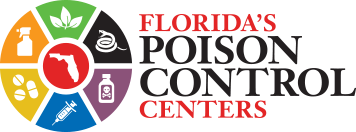Aquatic Toxins
Florida’s poison control centers take calls about marine stings and food-borne illnesses associated with seafood and Florida red tide. Poison specialists collect information from callers about what happened and provide immediate advice about their current symptoms. Poison centers also can connect physicians with Board-certified medical toxicologists for assistance treating poisoned patients.
The most common water-related calls to poison centers involve fish stings. These include stings from fish with venomous spines including the catfish, the lionfish, the scorpion fish and others. These stings generally cause localized pain and swelling but can also lead to dangerous allergic reactions. Fish stings can often be safely and effectively treated on site with the advice of a poison specialist. Call the poison center immediately for detailed instructions.
Jellyfish stings also prompt many calls to poison centers, and can often be treated on site without the need for emergency care. The stinging cells (called nematocysts) of the Portuguese man o’ war, upside-down jellyfish, lion’s mane jellyfish and others can cause serious pain, and even scarring, if not treated correctly. Poison centers recommend a multi-step approach that reduces pain and swelling within minutes. Call the poison center for detailed instructions from a certified poison specialist. Note: this process does not include urinating on the victim!
Invertebrates: Jellyfish, Coral, Man-of-War, Anemones
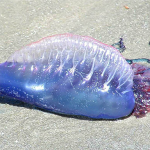 Stinging cells eject a poison whip-like hair when touched. Rubbing the tentacles causes more nematocysts to sting.
Stinging cells eject a poison whip-like hair when touched. Rubbing the tentacles causes more nematocysts to sting.
Point of Injection
Red welts and pain
Possible Symptoms
Shock, vomiting, diarrhea, headache, muscle spasms, chest or abdominal pain, chills
First Aid
Never rub the sting site. Rinse with seawater (not fresh water), vinegar or alcohol. Fix remaining tentacles with shaving cream, flour, or talc, and scrape matter off with a dull knife.
Vertebrates: Stingrays, Catfish, Urchins, Stonefish, Scorpionfish and Lionfish
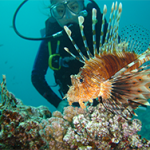 These creatures have venom-coated spines, portions of which may be left embedded in the wound.
These creatures have venom-coated spines, portions of which may be left embedded in the wound.
Point of Injection
Painful puncture wound, often deep. Shooting pain, swelling, bruising.
Possible Symptoms
Vomiting, diarrhea, fever, muscle cramps, weakness, infection, allergic reaction
First Aid
Soak in hot soapy water (110 degrees Fahrenheit) for 30-90 minutes to inactivate the venom. No ice or cold water should be applied. Take the victim to a nearby hospital for a tetanus shot and to remove foreign matter, or for treatment of severe symptoms.
Florida Red Tide
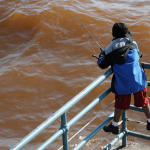 Eating clams, oysters or other shellfish from restricted areas during an active Florida red tide event can result in Neurotoxic Shellfish Poisoning or NSP.
Eating clams, oysters or other shellfish from restricted areas during an active Florida red tide event can result in Neurotoxic Shellfish Poisoning or NSP.
Symptoms
- Vomiting
- Diarrhea
- Stomach pain
- Tingling of the fingers
- Loss of feeling and control of the legs, and sometimes, Difficulty breathing
During a red tide event, sometimes called a “bloom,” poison centers get many calls from people affected by red tide toxins that are churned up by the waves and blown ashore. Symptoms can include:
- Coughing
- Sneezing
- Watery eyes
First Aid
If symptoms are severe, call 911 for emergency treatment. If symptoms are mild, contact the poison center or visit your doctor. It is safe to eat fish and shellfish sold in restaurants during a Florida red tide, since restaurants receive commercially harvested seafood only from safe areas. Find more information about where to safely harvesting shellfish here.
People with asthma or lung disease may find their usual symptoms get worse when they’re near the beach on a red tide day, especially on days with an onshore breeze. Returning to an air-conditioned area usually relieves discomfort. Anyone who experiences continued difficulty breathing after being on the beach during a red tide event should seek medical attention at once.
More Information
For more information, please visit the Florida Department of Health Aquatic Toxins Program website; for current red tide conditions, consult the “Red Tide Current Status” report from the Florida Fish and Wildlife Conservation Commission. Both of these websites provide detailed information on red tide and other marine toxins, including health information.
To report symptoms from Florida red tide or any aquatic toxin, call 1-800-222-1222 to speak to a poison specialist immediately.
To report fish kills to the Florida Fish and Wildlife Research Institute, call 1-800-636-0511.
View current beach conditions for selected Florida beaches, or call 941-BEACHES.
Ciguatera
 Ciguatera is a marine toxin illness that can result from eating large coral reef fish (such as grouper, red snapper, barracuda and hogfish, among others).
Ciguatera is a marine toxin illness that can result from eating large coral reef fish (such as grouper, red snapper, barracuda and hogfish, among others).
Symptoms
Symptoms of ciguatera usually appear within six to 24 hours of eating the contaminated fish, and can include:
- Vomiting
- Abdominal pain
- Diarrhea
- Unusual sensations (such as aching in the muscles, joints or teeth, tingling in the hands or feet and painful urination)
The classic symptom of ciguatera is that cold things feel hot to the touch or “burn.” These symptoms can recur for weeks or months after initial exposure.
While there is no FDA-approved method for testing fish for the ciguatera toxin, there are several ways to reduce your risk. If you fish from reefs, avoid eating large fish, especially of species known to carry ciguatera (including barracuda, red snapper, grouper and hogfish). Also, ask local experts for advice about species or areas to avoid. Cooking or freezing fish does not destroy ciguatoxin, and the contaminated fish does not smell, look or taste bad.
First Aid
It is possible to treat ciguatera if the condition is diagnosed within the first two to three days after eating contaminated fish. Physicians treating suspected cases of ciguatera could receive a free consult with a medical toxicologist by calling 1-800-222-1222. If more than two or three days have passed since the contaminated fish has been eaten, avoidance of dehydration and certain foods (such as caffeine, nuts, and fish) may help reduce symptoms.
More Information
For more information about ciguatera, or to report a case, call the Florida Department of Health Aquatic Toxins Program at 850-245-4250.
Shellfish Poisoning
 Shellfish poisoning in Florida usually results from the consumption of raw shellfish contaminated by bacteria or a virus. Symptoms of this type of poisoning generally involve several days of gastrointestinal upset and sometimes fever.
Shellfish poisoning in Florida usually results from the consumption of raw shellfish contaminated by bacteria or a virus. Symptoms of this type of poisoning generally involve several days of gastrointestinal upset and sometimes fever.
Shellfish in Florida can also be contaminated with naturally occurring marine toxins. These rare marine toxin-related illnesses include: Neurotoxic Shellfish Poisoning or NSP; Paralytic Shellfish Poisoning or PSP; and Amnesic Shellfish Poisoning or ASP. All of these illnesses can be caused by eating clams, mussels or oysters that have been exposed to the micro-algae responsible for red tides or other harmful algal blooms (HABs).
Symptoms
Symptoms can appear within minutes to several hours after contaminated shellfish is eaten, and may include tingling sensations in the lips or extremities, unusual sensations of hot and cold, vomiting, diarrhea, and sometimes a loss of coordination that can result in staggering or difficulty walking. The symptoms usually last several days and then go away, but elderly individuals, children and people who have chronic health problems can experience more serious illness. Sometimes, particularly with PSP and ASP, difficulty breathing can occur.
First Aid
If you believe you’ve become sick from eating shellfish, contact the poison center or your doctor immediately and, if possible, save some of the shellfish for testing.
More Information
The Florida Department of Agriculture and Consumer Services conducts an excellent monitoring program that routinely tests shellfish beds and closes any determined to be unsafe. Detailed shellfish bed closure information is available here; click “View Status of Shellfish Harvesting Areas.” Most reported cases of toxin-related shellfish poisoning in Florida are the result of individuals harvesting shellfish during a restricted period. Commercial shellfish operations that supply restaurants are careful to avoid closed areas, and monitor their harvests routinely for the presence of toxins. Unfortunately, there is no method for the home testing of shellfish that is approved by the FDA, and cooking or freezing does not destroy these toxins. Thoroughly cooking shellfish is an effective way of minimizing bacteria and viral contamination, and remains the best way to protect against most shellfish-related illnesses.
For more information about how to safely enjoy Florida fish and shellfish call the Florida Department of Health Aquatic Toxins Program at 850-245-4250.
Blue-Green Algae
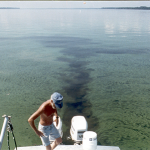 There are a variety of blue-green algae (or cyanobacteria) species in Florida that produce natural toxins harmful to humans, pets and livestock. Usually these toxins only reach harmful levels when there’s a “bloom” (an overgrowth of algae) in slow moving or standing water. Blue-green algae can appear as thick mats of “pond scum” or can be dispersed through the water, turning it various intense colors of green, brown, or even red. Blue-green algae blooms can sometimes produce a bad smell.
There are a variety of blue-green algae (or cyanobacteria) species in Florida that produce natural toxins harmful to humans, pets and livestock. Usually these toxins only reach harmful levels when there’s a “bloom” (an overgrowth of algae) in slow moving or standing water. Blue-green algae can appear as thick mats of “pond scum” or can be dispersed through the water, turning it various intense colors of green, brown, or even red. Blue-green algae blooms can sometimes produce a bad smell.
Symptoms
People exposed to high levels of blue-green algae toxins while swimming or boating sometimes report symptoms within hours of being exposed including:
- Itchy rash
- Stomachache
- Diarrhea
First Aid
Rinsing off with fresh water and immediately removing clothing can reduce symptoms. It’s very important that pets, livestock and small children be kept out of water suspected of having a blue-green algae bloom. There have been reported cases of animals dying after drinking highly contaminated water. Anyone experiencing symptoms after contact with algae should consult with the poison control center or their doctor immediately.
More Information
It is unclear why blue-green algae bloom and produce these toxins, although it appears that reducing fertilizer use near waterways may help prevent blooms. For more information online on blue-green algae toxins and their health effects, please contact the Florida Department of Health Aquatic Toxins Program at 850-245-4250.

